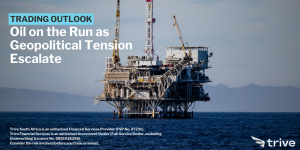
Leverage is a strategic tool that has captivated traders, offering a gateway to the lucrative potential within the trading world. Picture this: the ability to enhance your trade exposure by utilizing borrowed funds, elevating your market exposure far beyond the constraints of your available cash.
In essence, leverage enables traders to navigate the markets with heightened potential. The underlying principle is simple yet powerful – a leveraged position can magnify returns when market conditions align with your outlook. However, caution prevails as the double-edged nature of leverage becomes apparent; in adverse market movements, losses have the potential to be accentuated.
- How does leverage work?
The concept of leverage is relatively simple. The process involves posting margin, which can be considered similar to a deposit, representing a fraction of the total value of your trade exposure. The remaining funds are then borrowed from the broker to provide you with a large exposure to the market while only needing a small initial outlay. Let’s look at an example.
- Trader A (No Margin):
- Buys 100 shares of Company A at $50 (Initial outlay = $5,000)
- Share price goes up 10% to $55 and trader sells (Selling value = $5,500)
- Total Profit = $500 (10% of invested funds)
- Trader B (Margin): 20% Margin Requirement
- With a $5,000 initial outlay, a trader can get exposure of $25,000 by borrowing the remaining $20,000 from the broker.
- Position worth $25,000 and share price appreciates by 10%
- Selling Value = $27,500
- Profit = $2,500
- Trader put down $5,000 and made $2,500 profit (50% return on invested funds)
In this basic example of a leveraged trade, the benefits become evident. However, it should be noted that any movement in an adverse direction will have the same effect. In a leveraged trade, the trader’s losses will be amplified in the same way as the profits shown above.
- Important Concepts
- Margin Requirements
To trade with leverage, a trader may require a margin account. This is an account in which the broker would lend the trader funds to purchase more securities than would otherwise be possible with the available balance in the account. Margin requirements refer to the portion of marginable securities that the trader must pay with their own funds. Margin requirements can be broken down into initial margin and maintenance margin.
- Initial Margin
The initial margin requirement is the percentage of equity that is required to open a position. In simple terms, this is the percentage of the total market value of the purchase that the trader must pay in cash. For example, an initial margin requirement of 50% would provide a trader with $20,000 in purchasing power if a deposit of $10,000 is made. The purchasing power multiplier can be used to determine the trader’s buying power based on the initial margin requirement.
- Purchasing Power Multiplier = (1/Initial Margin %)
Therefore, an initial margin requirement of 50% will provide the trader with (1/0.5) = 2X buying power. Similarly, a 20% initial margin requirement provides the trader with (1/0.20) = 5X buying power. In this case, a deposit of $100,000 would have purchasing power worth $500,000, where the remaining $400,000 is borrowed from the broker.
- Maintenance Margin
After the initial deposit has been made and a trade has been executed, the maintenance margin will come into play. This is the minimum amount of money a trader must hold in the margin account after making a purchase. If the account’s net asset value falls below this maintenance requirement, a margin call will occur. Let’s look at an example:
A trader wants to buy 100 shares of a company at $20 each. With a 50% initial margin, the trader would need to deposit $1,000 and borrow the remaining $1,000 from the broker. The maintenance margin is 40%. If the stock price falls to $14, the amount of the trader’s invested equity has fallen from $1,000 to $700 (0.5 X 100 X 14). However, the maintenance requirement is $800 (0.4 X 2,000). Therefore, the investor’s account has fallen below the maintenance requirement, and the broker could send a margin call to the investor to either deposit more cash or sell some securities to make up for the difference between the maintenance margin requirement and the account’s value.
- Margin Call
As previously mentioned, a margin call occurs when an investor or trader’s equity in the margin account falls below the maintenance margin requirements. When this occurs, the trader usually has a short grace period in which to restore the account value to meet the margin requirements. The margin call is a demand from the broker which requires the customer to either inject additional cash or sell part of the security in order to bring the account value back to the required minimum. If the trader fails to adhere to the margin call, the broker may sell part of the existing securities to restore the required margin level. The formula for the price at which a margin call will occur is as follows:
- Margin Call Price = Purchase Price X (1-Initial Margin)/(1-Maintenance Margin)
For example: If a trader purchases a security for $1,000 with an initial margin requirement of 50% and a 25% maintenance margin, a margin call will occur at 1,000 X (1 – 0.5)/(1 – 0.25) = $666.67.
Summary
In essence, leverage in trading is a potent tool that allows traders to amplify their market exposure using borrowed funds. While it can magnify profits when the market moves favourably, caution is essential due to the potential for amplified losses in adverse market conditions. Key concepts to be aware of include margin requirements involving initial and maintenance margins, which determine the trader’s purchasing power and the risk of margin calls if the account falls below the maintenance margin level.
Sources: Corporate Finance Institute, Investopedia, Business Insider
Piece written by Tiaan van Aswegen, Trive Financial Market Analyst
Disclaimer: Trive South Africa (Pty) Ltd (hereinafter referred to as “Trive SA”), with registration number 2005/011130/07, is an authorised Financial Services Provider in terms of the Financial Advisory and Intermediary Services Act, 37 of 2002. Trive SA is authorised and regulated by the South African Financial Sector Conduct Authority (FSCA) and holds FSP number 27231. Trive Financial Services Ltd (hereinafter referred to as “Trive MU”) holds an Investment Dealer (Full-Service Dealer, excluding Underwriting) Licence with licence number GB21026295 pursuant to section 29 of the Securities Act 2005, Rule 4 of the Securities Rules 2007, and the Financial Services Rules 2008. Trive MU is authorized and regulated by the Mauritius Financial Services Commission (FSC) and holds Global Business Licence number GB21026295 under Section 72(6) of the Financial Services Act. Trive SA and Trive MU are collectively known and referred to as “Trive Africa”.
Market and economic conditions are subject to sudden change which may have a material impact on the outcome of financial instruments and may not be suitable for all investors. Trive Africa and its employees assume no liability for any loss or damage (direct, indirect, consequential, or inconsequential) that may be suffered. Please consider the risks involved before you trade or invest. All trades on the Trive Africa platform are subject to the legal terms and conditions to which you agree to be bound. Brand Logos are owned by the respective companies and not by Trive Africa. The use of a company’s brand logo does not represent an endorsement of Trive Africa by the company, nor an endorsement of the company by Trive Africa, nor does it necessarily imply any contractual relationship. Images are for illustrative purposes only and past performance is not necessarily an indication of future performance. No services are offered to stateless persons, persons under the age of 18 years, persons and/or residents of sanctioned countries or any other jurisdiction where the distribution of leveraged instruments is prohibited, and citizens of any state or country where it may be against the law of that country to trade with a South African and/or Mauritius based company and/or where the services are not made available by Trive Africa to hold an account with us. In any case, above all, it is your responsibility to avoid contravening any legislation in the country from where you are at the time.
CFDs and other margin products are complex instruments and come with a high risk of losing money rapidly due to leverage. You should consider whether you understand how these products work and whether you can afford to take the high risk of losing your money. Professional clients can lose more than they deposit. See our full Risk Disclosure and Terms of Business for further details. Some or all of the services and products are not offered to citizens or residents of certain jurisdictions where international sanctions or local regulatory requirements restrict or prohibit them.




